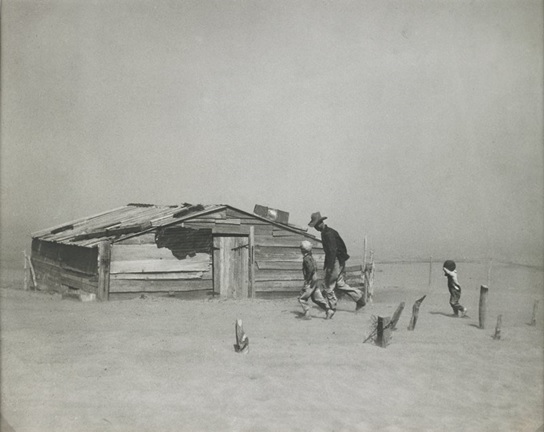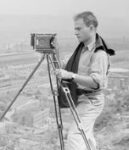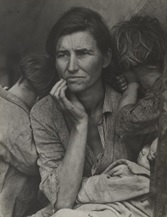
Arthur Rothstein
American, 1915-1985
Dust Storm, Cimarron County, Oklahoma, 1936
gelatin silver print
10 5/8 x 10 1/2 in.
SBMA, Gift of the Artist
1977.54.3

Arthur Rothstein, photographer, Farm Security Administration Collection, Library of Congress, 1938
“Because powerful images are fixed in the mind more readily than words, the photographer needs no interpreter. A photograph means the same thing all over the world and no translator is required. Photography is truly a universal language, transcending all boundaries of race, politics and nationality.” - Arthur Rothstein [1]
“Just as I was about to finish shooting I saw a farmer and his two sons walk across the fields. As they pressed into the wind, the smallest child walked a few steps behind, his hands covering his eyes to protect them from the dust.” - Arthur Rothstein [2]
RESEARCH PAPER
Is the image a wasteland deep in the Australian Outback, perhaps the Mojave Desert, or even the Sahara? No, it is taken in Cimarron County, Oklahoma in 1936. The photograph is of a farmer's homestead in the panhandle of Oklahoma, formerly the “breadbasket” of America. Arthur Rothstein captures a moment of battle but a battle in a war that is all but lost. We see the farmer, and his two young sons leaning into the relentless wind. The sky and earth have merged into one with dust filling the sky and obscuring the ground. The three lean forward, fighting the wind and grit, to get back to their house which is just beyond the frame of the photo. The youngest child, last in line, struggles and covers his face to little avail. He is not helped or aided by his father, indicating the demon wind and dust is a normal part of their current lives.
The black and white photograph was taken by photographer Arthur Rothstein, hired by the Resettlement Administration, which would later become the Farm Security Administration (FSA) a branch of the Works Progress Administration (WPA) of The New Deal. He was the first staff photographer hired to participate in the photo-documentary project, to visually document the devastating effects of the [1929] depression on rural America.
It appears that this same photograph was printed at various times with several different titles. An alternative title is “Father and sons walking in the face of a dust storm” [3] “Fleeing a Dust Storm” is the title of the photo according to Errol Morris, the author of Believing Is Seeing (Observations on the Mysteries of Photography). [4]
When this photo was taken, it was not taken to be a “piece of art.” Rothstein did not intend for this or any of the approximately 14,000 photos that he took for the FSA to be framed, to hang on a living room wall or to grace the halls of a gallery or museum. [5] He took these photographs to send a political message, to support political policy and to educate fellow citizens of the life that others were living in far off corners of the nation.
According to Rothstein, “There was a need to produce a collection of photographs that would show the American people the terrible conditions under which farm people lived, the rural poverty, the migrant labor conditions, the environmental problems such as the Dust Bowl and the Great Drought that took place in those years and the general effects of the great depression. And it was a need to explain these problems as well as to justify the programs that Roosevelt and Tugwell had developed to alleviate these situations.” [6] This statement of societal purpose clearly reflects the influence of photographers Lewis Hine and Jacob Riis, both recognized as early founders of Social Reform Documentary photography of the 19th century. [4]
Arthur Rothstein attended Columbia University from the age of 16 through 20. He was president of the photography club at Columbia, and he earned spending money making photocopies for Economics teacher Roy Stryker. After Stryker joined the Roosevelt administration in Washington, he quickly contacted Rothstein and hired him.
Rothstein’s travels across the country brought him to Cimarron County Oklahoma, the most western tip of the Oklahoma panhandle, to the farm of Arthur Coble. He was 20 years old at the time and learned to drive to make the journey. There he shot the most famous photograph of his career. Art and his young sons Milton and Darryl became immortalized in this famed photograph much as Florence Thompson and her daughters were in “Migrant Mother” photographed by Dorothea Lange, also taken in 1936.
The account of the famous photograph has Rothstein capturing the scene in a moment of chance. Having finished taking various photographs of the farmer and his two sons and preparing to drive off, he states: “I was about to get into my car when I turned to wave to Coble and his two sons,” Rothstein later remembered. “And I looked and saw this man bending into the wind, with one of the boys in front of him and another one behind him, and great swirls of sand all around, which made the sky and the earth become one. And I said to myself, ‘What a picture this is!’ and I just picked up my camera and went ‘click.’ One photograph, one shot, one negative.” The image Rothstein captured at the Coble farm was soon widely reprinted across the country, touching emotional chords with everyone who saw it, becoming the iconic picture of the Dust Bowl and one of the most widely reproduced photographs of the 20th century. [7]
Of interest is that despite the horrific conditions that Rothstein eternalized on film, this family did not abandon their home as so many of their neighbors had done. Rothstein revisited this farm 15 and 25 years later to find the two children from “Dust Storm” still living and successfully farming the family land.
Arthur Rothstein became Director of Photography at Look Magazine in 1947 until the magazine ceased publication in 1971. He went on to hold the same position at Parade Magazine beginning in 1972. [8] He provided photography for other noted magazines and the New York Times.
Rothstein's photographs are in permanent collections throughout the world and have appeared in numerous exhibitions. A selection of these one-man shows include shows at the International Museum of Photography at George Eastman House; the Smithsonian Institution; Photokina; Corcoran Gallery of Art; Royal Photographic Society, as well as traveling exhibitions for the United States Information Service and for Parade magazine.
He was a member of the faculty of the Columbia University Graduate School of Journalism and a Spencer Chair Professor at S. I. Newhouse School of Public Communications, Syracuse University. Rothstein was also on the faculties of Mercy College, and the Parsons School of Design in New York City. [9]
Farm Security Administration photographers also represented in the SBMA collection include: Dorothea Lange, Ben Shahn, Marion Post Wolcott, Walker Evans.
Prepared for the Santa Barbara Museum of Art Docent Council by Larry Rehr, Februaru 2023
BIBLIOGRAPHY
1. Getty Museum Collection. January 2023.
https://www.getty.edu/art/collection/person/103KFD
2. Photography of the Great Depression. January 2023.
https://lis471.wordpress.com/Arthur-Rothstein/
3. Sandler, Martin W. “Picturing a Nation.” Summerville, MA, Candlewick Press, 2021. Page 61.
4. Morris, Errol. “Believing is seeing (observations on the mysteries of photography). New York, Penguin Press, 2011. Page 169.
5. Sandler, Martin W. “Picturing a Nation.” Summerville, MA, Candlewick Press, 2021. Page 148.
6. The New Deal for Artists. Documentary film directed by Wieland Schulz-Keil. Interview with Arthur Rothstein, 1979 minute 5:01.
7. The Arthur Rothstein Legacy Project, Ann Rothstein Segan, PhD. January 2023.
https://arthurrothstein.org/about-us/
8. Sandler, Martin W. “Picturing a Nation.” Summerville, MA, Candlewick Press, 2021. Page148.
9. The Arthur Rothstein Legacy Project, Ann Rothstein Segan, PhD. January 2023.
https://arthurrothstein.org/about-us/

Dorothea Lange - Migrant Mother, 1936, Library of Congress
